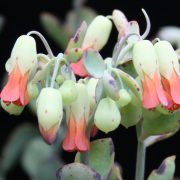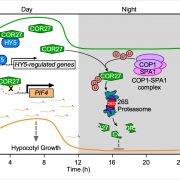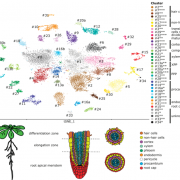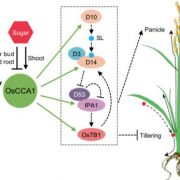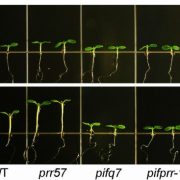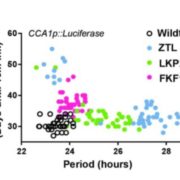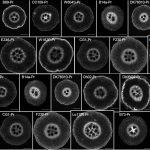SIGMA FACTOR5 protects freezing plants
Low temperatures quickly and reversibly inhibit photosynthesis, which is assumed to shield the photosynthetic system from a drop in metabolic activity brought about by cold. In a recent study, 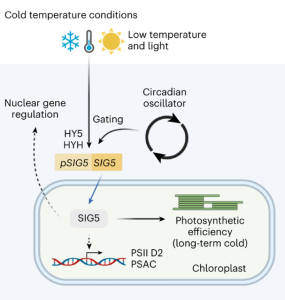 Cano-Ramirez et al. found that in Arabidopsis, a nuclear-encoded sigma factor (SIG5) controls chloroplast transcription and contributes to adaptation to low-temperature conditions. In prokaryotes, sigma factors contribute to promoter targeting of RNA polymerases, and this function is conserved in the plant plastid-encoded RNA polymerase. The sigma factor-encoding genes have been transferred to the nuclear genome from the plastid genome in plants, providing a mechanism for nucleus to plastid signaling. The authors showed that ELONGATED HYPOCOTYL5 (HY5) and HY5 HOMOLOG (HYH) influence SIG5 accumulation. Previous studies have indicated that both SIG5 and HY5 participate in circadian signaling, and that other responses to cold are gated (modulated) by the time of day. The authors showed that the time at which the cold treatment is applied affects the magnitude of SIG5 transcript level and transcriptional activity, mediated by HY5 and HYH. Because SIG5 regulates the transcription of the gene encoding the D2 protein (psbD) of photosystem II (PSII), its role in enhancing photosynthetic efficiency during long-term cold and freezing exposure via HY5/HYH and the circadian clock provides an interesting opportunity to increase crop yield under low-temperature stress. Furthermore, this study indicates that sigma factors are involved in cold-temperature responses in both prokaryotes and eukaryotes. (Summary by Rajarshi Sanyal, @rajarshi_sanyal. Nature Plants, 10.1038/s41477-023-01377-1)
Cano-Ramirez et al. found that in Arabidopsis, a nuclear-encoded sigma factor (SIG5) controls chloroplast transcription and contributes to adaptation to low-temperature conditions. In prokaryotes, sigma factors contribute to promoter targeting of RNA polymerases, and this function is conserved in the plant plastid-encoded RNA polymerase. The sigma factor-encoding genes have been transferred to the nuclear genome from the plastid genome in plants, providing a mechanism for nucleus to plastid signaling. The authors showed that ELONGATED HYPOCOTYL5 (HY5) and HY5 HOMOLOG (HYH) influence SIG5 accumulation. Previous studies have indicated that both SIG5 and HY5 participate in circadian signaling, and that other responses to cold are gated (modulated) by the time of day. The authors showed that the time at which the cold treatment is applied affects the magnitude of SIG5 transcript level and transcriptional activity, mediated by HY5 and HYH. Because SIG5 regulates the transcription of the gene encoding the D2 protein (psbD) of photosystem II (PSII), its role in enhancing photosynthetic efficiency during long-term cold and freezing exposure via HY5/HYH and the circadian clock provides an interesting opportunity to increase crop yield under low-temperature stress. Furthermore, this study indicates that sigma factors are involved in cold-temperature responses in both prokaryotes and eukaryotes. (Summary by Rajarshi Sanyal, @rajarshi_sanyal. Nature Plants, 10.1038/s41477-023-01377-1)


